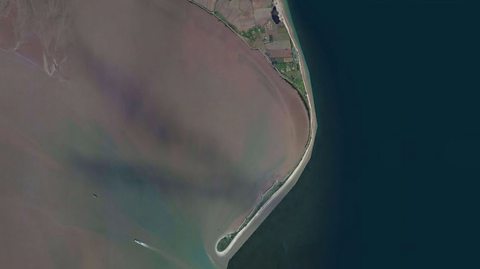Reasons for coastal defence
People live near the coast: In all continents around the world (except Africa), settlement is concentrated along the coastline.Good communication links, job opportunities and the shoreline environment make it a popular place to live. As a result, house prices along the coast are often very high, but these expensive houses and their surrounding infrastructure need protection.
Coastal areas are important economically: Countries rely on their ports for trading goods, both imports and exports. Because of this many industries are based in coastal areas. The coast also provides effective transport links, including roads and railway lines that are more easily built along flatter shorelines. Fishing ports are one special reason for a coastal location. In recent years, global tourism has grown rapidly, and coastal areas are especially attractive. For example, in Northern Ireland, hotels, guest houses and caravan parks are found in coastal areas near key attractions such as Titanic Quarter, the Royal County Down golf links and the Giants Causeway. All these factors provide jobs and income for coastal areas.
Sea levels rise as a result of climate change:The greenhouse effectThe trapping of the sun’s heat in the earth’s atmosphere by gases such as methane, carbon dioxide and water vapour. An increased greenhouse effect can lead to climate change.has caused global temperatures to rise. global warmingThe rise in the average temperature of the Earth's surface. over recent years is causing the global climate to change. One direct effect is an increase in the rise of sea levels. In the UK sea levels around the UK have risen by 16.5cm. If the sea levels continue to rise, many low-lying areas such as the Netherlands and Bangladesh are going to suffer severe consequences.
Methods of coastal management
Hard and soft engineering methods can be used to manage the erosionThe wearing away of pieces of rock, soil or other solid materials. and flooding at the coast.
hard engineeringThe use of man-made structures to control the coast. methods involve building structures to stop erosion and flooding to protect the coast.
soft engineeringThe use of natural, sustainable solutions to control the coast. are usually more ecologically sensitive. They will attempt to coastal management strategiesA range of measures which can be taken to help stop coastal erosion processes from eroding away land at the coast.erosion and floods.
Hard engineering options tend to be expensive, they often have a high impact on the physical landscape and may be economically unsustainable… They may also have a high impact on the landscape or environment and be unsustainable.
Sea wall
A solid wall that is used to separate the land from the sea.
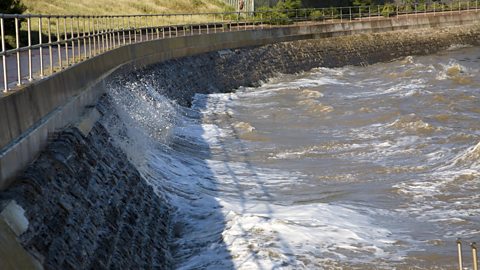
| Advantages | Disadvantages |
|---|---|
| Protects the base of cliffs, land and buildings against erosion. They can prevent coastal flooding in some areas. | Expensive to build and maintain. Curved sea walls reflect the energy of the waves back to the sea. This means that the waves remain powerful. Can also be unattractive. |
Groynes
A groyne is a wooden barrier built at right angles to the beach.
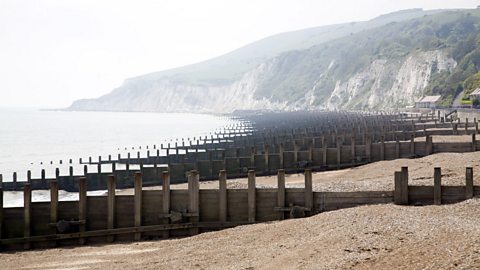
| Advantages | Disadvantages |
|---|---|
| Prevents longshore drift moving beach material along the coast. Allows the build-up of a beach. Beaches are a natural defence against erosion and an attraction for tourists. | They can be unattractive. Costly to build and maintain. |
Gabions
Gabions are large boulders piled up on the beach in steel cages.
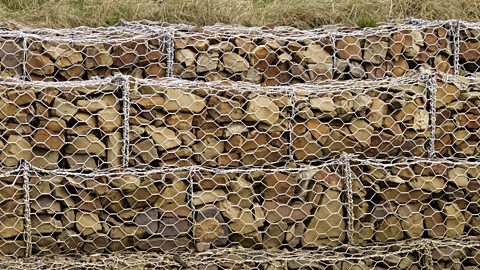
| Advantages | Disadvantages |
|---|---|
| These absorb wave energy and may also trap sediment to the build-up the beach. | It may be expensive to obtain and transport the boulders needed for gabions. They also look unattractive. |
Soft engineering methods
Soft engineering methods are often less expensive than hard options, at least initially. They are usually more sustainableAn activity which does not consume or destroy resources or the environment. in the long-term and are designed to have a less negative impact on the environment.
There are two main types of soft engineering.
Beach nourishment
- Replaces beach or cliffA high, steep wall of rock that can be eroded by the sea. material that has been removed by erosion or Longshore driftWhen eroded material in the sea is carried along the beach in a zig zag course.
- The main advantage is that beaches are a natural defence against erosion and coastal flooding. Beaches also attract tourists
- Relatively inexpensive option but requires constant maintenance to replace the beach material as it is washed away.

Managed retreat
- Areas of the coast are allowed to erode and flood naturally. Usually this will be areas considered to be of low value - e.g. places not being used for housing or farmland.
- The advantages are that it encourages the development of beaches (a natural defence) and salt marshes (important for the environment) and cost is low.
- managed retreatWhen land management is used to allow erosion and/or flooding to occur on marginal land so that more valuable land can be protected. is a cheap option, but people will need to be compensated for loss of buildings and farmland.
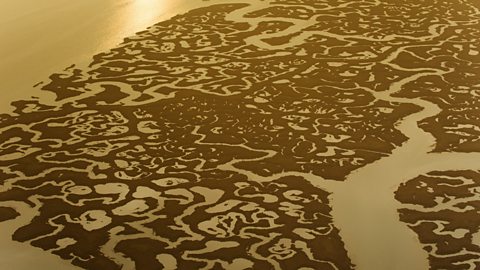
Principles of sustainable development
The United Nations have defined sustainability in 1987 as,
“Development that meets the needs of the present without compromising the ability of future generations to meet their own needs.”
An evaluation that refers to the principles of sustainable development needs to consider the social, environmental and economic impacts that each management strategy might have.
Social impacts refer to how a management method will affect people. It will look at how it impacts their houses and where they live, how it will affect their daily lives and their food and water supply.
Environmental impacts refer to how management methods will impact the natural environment. How will any development affect animals and plant life in the local area? How will it impact water quality and sewage?
Economic impacts refer to how the management methods used will affect how people work. How will this affect jobs and income? Will the measure make people richer or poorer – will it have a positive or negative impact on their livelihood?
Case Study: Sustainable coastal management strategy
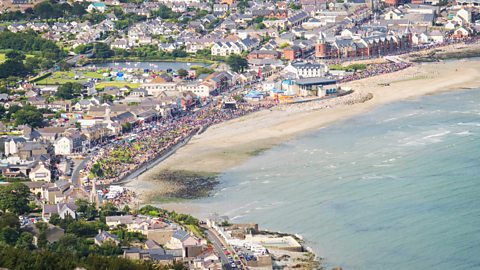
The tourist resort of Newcastle, Co Down has long been under attack from the sea and has regularly caused flooding along the main street.
The local council have changed their management strategy for the area over the years. A number of measures have been used to manage the coastline over the last 100 years.
The late 20th Century
Groynes
As Newcastle became increasingly popular following the Second World War as a tourist resort, the council took measures to retain the beach as it was constantly being eroded away and the material was being moved along the coast.
A series of wooden groynesWooden, concrete or rock barriers that are built at 90 degrees to the coastline so that they will trap sand carried along the shore by longshore drift. were built.
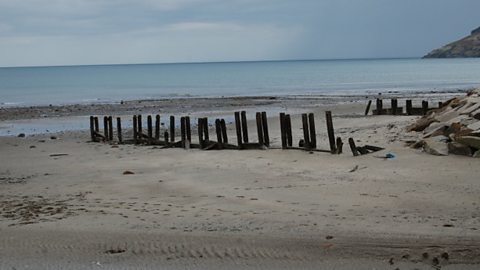
| Positives | Negatives |
|---|---|
| Easy to build into the coastline | As the groynes help to build up a beach in one place, there will be another place along the coastline that is now not getting any sand. |
| Relatively inexpensive. | Wooden groynes need constant maintenance and replaced every 10 – 15 years |
| Helps to trap the sand as it is carried along the shore by longshore drift. | Some people do not like the look of the groynes and people who like to walk along the beach don’t like having to climb up over these barriers. |
Gabions
In the 1990s, one major area of concern was the piece of coastline at the Slieve Donard hotel and the sand dunes along Dundrum Bay.
Many gabionsMetal cages that are filled with rocks and stacked together to form a rock barrier that will absorb wave energy. were installed along the coast to stop the erosionThe wearing away of pieces of rock, soil or other solid materials. of the sand dunes and the beach in front of it. Some of the gabions lasted for 10 years but many had to be replaced on an annual basis.
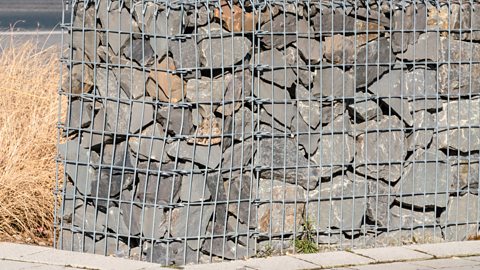
| Positives | Negatives |
|---|---|
| Gabions are just metal cages that are filled with rocks and are very inexpensive. | The rock cages can often split due to the energy caused by winter storms. They need to be repaired and replaced frequently. |
| The rock cages are stacked together and as the waves hit the cages the wave energy is absorbed by the gaps in the rocks. This means that there is no energy left to cause any erosion. | The cages are unattractive. Pollution and litter can build up which provides a breeding ground for rats. |
| Can be used very quickly to form a temporary or a more permanent solution. |
The early 21st Century
A sea wallsA solid wall that is used to separate the land from the sea. Often these are shaped to reflect wave energy back into the sea. has been used for many years to help manage the coast.
In 2007 a new Newcastle promenade development was completed that raised the sea wall by 1m and provided a new curved wall that would continue to protect the seafront landscape.
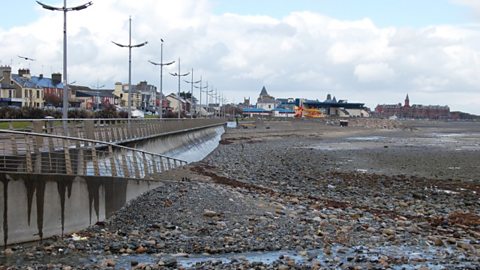
| Positives | Negatives |
|---|---|
| Protects the land and when built high enough will also prevent coastal flooding. | The improvements in 2007 cost over ÂŁ4 million for a relatively short section of wall. |
| The curved sea wall will ensure that wave energy is reflected back out into the sea. | They need deep foundations – so will require a lot of building work. This can disrupt the natural habitats of animals. |
| Sea walls can also help shape the landscape and provide walkways and urban architecture | As they reflect the wave energy back, this can cause coastal erosion either further along the coast or back in the sea where the waves eventually fall. |
| Often require replacement every 25 years. |
Newcastle: Evaluation of the principles of sustainable development
Economic
Hard engineering defences are expensive especially the new enlarged and curved sea wall. Concrete groynes built across the beach in the 1980s are no longer effective and may need to be replaced. The gabions placed at the mouth of the Shimna River need annual maintenance. The future use of soft engineering by beach nourishment will be costly and needs to be repeated. However, protecting the town’s buildings, its summer population of 15000 people, including visitors and the tourist trade may mean the high cost is sustainable.
Environment
The beach at Newcastle has been losing sand for decades and the old concrete and timber groynes are no longer effective at retaining the beach. The curved sea wall deflects wave energy from the shore back onto the beach causing sand to be carried away. However, sea shore habitats have been damaged with plants, animals and birdlife negatively impacted. Any changes to the coastal defences at Newcastle will have impacts along the coast, putting at risk the beach and sand dunes of Murlough Nature Reserve, further north along Dundrum Bay.
Social
A safe, protected beach is good for the people of the town and visitors. It will help secure houses and jobs for local people. However, further along the coast any alteration may impact other people’s property and jobs. For example, increased erosion of the grounds of the Slieve Donard Hotel, the Royal County Down Golf Resort or the army base at Ballykinler.
Watch: Newcastle's coastal management techniques
Case study: The coastal management techniques used in Newcastle, County Down.
Activity: Take the test
More on Coastal environments
Find out more by working through a topic
- count1 of 4

- count2 of 4
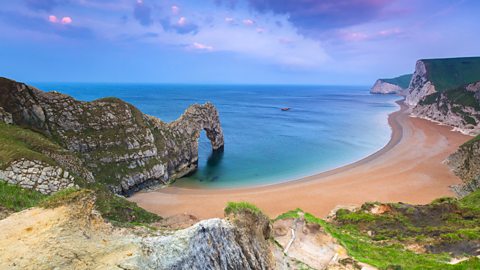
- count3 of 4
